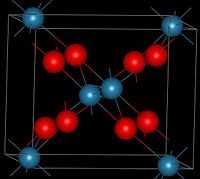Rhenium(IV) oxide
 | |
| Names | |
|---|---|
| IUPAC name
Rhenium(IV) oxide | |
| Other names
Rhenium dioxide | |
| Identifiers | |
| 12036-09-8 | |
| EC number | 234-839-0 |
| |
| Jmol-3D images | Image |
| PubChem | 82847 |
| |
| Properties | |
| ReO2 | |
| Molar mass | 218.206 g/mol |
| Appearance | gray orthorhombic crystals |
| Density | 11.4 g/cm3[1] |
| Melting point | decomposes at 1000 °C[2] |
| insoluble | |
| Solubility in alkali | insoluble |
| Structure | |
| Crystal structure | Orthorohmbic, oP12 |
| Space group | Pbcn, No. 60 |
| Hazards | |
| MSDS | Aldrich MSDS |
| NFPA 704 | |
| Related compounds | |
| Other anions |
Rhenium(VII) oxide Rhenium(III) oxide Rhenium(III) chloride |
| Other cations |
manganese(IV) oxide Technetium(IV) oxide |
| Except where noted otherwise, data is given for materials in their standard state (at 25 °C (77 °F), 100 kPa) | |
| | |
| Infobox references | |
Rhenium(IV) oxide or rhenium dioxide is the inorganic compound with the formula ReO2. This gray to black crystalline solid is a laboratory reagent that can be used as a catalyst. It adopts the rutile structure.
Synthesis and reactions
It forms via comproportionation:[3]
- 2 Re2O7 + 3 Re → 7 ReO2
At high temperatures it undergoes disproportionation:
- 7 ReO2 → 2 Re2O7 + 3 Re
It forms perrhenates with alkaline hydrogen peroxide and oxidizing acids.[4] In molten sodium hydroxide it forms sodium rhenate:[5]
- 2 NaOH + ReO2 → Na2ReO3 + H2O
References
- ↑ Lide, David R. (1998). Handbook of Chemistry and Physics (87 ed.). CRC Press. p. 484. ISBN 0-8493-0594-2. Retrieved 2008-06-05.
- ↑ Perry, Dale L.; Phillips, Sidney L. (1995). Handbook of Inorganic Compounds. San Diego: CRC Press. p. 328. ISBN 0-8493-8671-3. Retrieved 2008-06-05.
- ↑ G. Glemser "Rhenium (IV) Oxide" Handbook of Preparative Inorganic Chemistry, 2nd Ed. Edited by G. Brauer, Academic Press, 1963, NY. Vol. 1. p. 1480.
- ↑ "RHENIUM DIOXIDE - Manufacturer". Aaamolybdenum.com. Retrieved 2012-08-06.
- ↑ G. Glemser "Sodium Rhenate (IV)" Handbook of Preparative Inorganic Chemistry, 2nd Ed. Edited by G. Brauer, Academic Press, 1963, NY. Vol. 1. p. 1483.
| ||||||||||||||||||||||||||||||||||||||||
